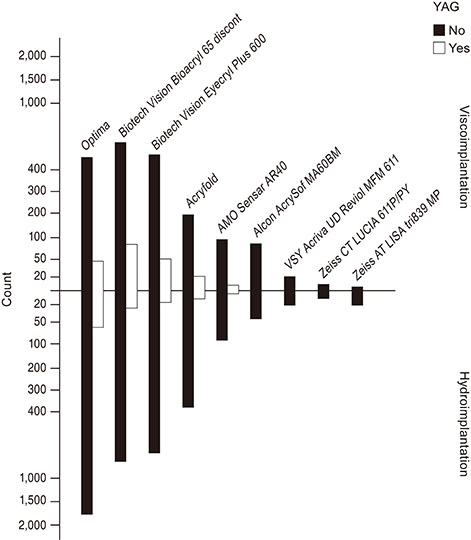Korean J Ophthalmol.
2019 Jun;33(3):222-227. 10.3341/kjo.2018.0122.
Comparison of the Neodymium-doped Yttrium Aluminum Garnet Capsulotomy Rate with Viscoimplantation and the Hydroimplantation Intraocular Lens Technique
- Affiliations
-
- 1Department of Ophthalmology, Kırıkkale University Medical Faculty, Kırıkkale, Turkey. ogureltevfik@kku.edu.tr
- 2Reyhan Ogurel Eye Clinc, Kırıkkale, Turkey.
- 3Kudret Eye Hospital, Kırıkkale, Turkey.
- KMID: 2448861
- DOI: http://doi.org/10.3341/kjo.2018.0122
Abstract
- PURPOSE
To investigate the rate of neodymium-doped yttrium aluminum garnet (Nd:YAG) laser capsulotomy in the hydroimplantation intraocular lens (IOL) technique.
METHODS
This retrospective study was comprised of 6,192 eyes in 3,790 patients who underwent surgery from January 2013 to September 2017 and then were followed up for at least 1 year. The eyes of these patients were divided into two groups: either viscoimplantation or hydroimplantation. The follow-up examinations were carried out on the 1st day, 4th day, 1st month, and 3 months to 1 year postoperatively. The Nd:YAG capsulotomy rates were evaluated by the different IOL implantation techniques and IOL materials.
RESULTS
The mean follow-up duration of the patients was in the viscoimplantation group 14.85 ± 2.43 and 15.05 ± 1.93 months in the hydroimplantation group. The Nd:YAG capsulotomy rate was significantly lower in the hydroimplantation group compared with the viscoimplantation group for the entire hydrophilic IOL model (p < 0.001). In addition, the Nd:YAG rate was lower in the hydroimplantation group that used a hydrophilic IOL than it was in the viscoimplantation group, which used a hydrophobic IOL.
CONCLUSIONS
The hydroimplantation technique reduced the Nd:YAG capsulotomy rate.
Keyword
MeSH Terms
Figure
Reference
-
1. Schriefl SM, Menapace R, Stifter E, et al. Posterior capsule opacification and neodymium:YAG laser capsulotomy rates with 2 microincision intraocular lenses: four-year results. J Cataract Refract Surg. 2015; 41:956–963.
Article2. Menapace R. After-cataract following intraocular lens implantation. Part I. Genesis and prevention by optimizing conventional lens implants and surgical techniques. Ophthalmologe. 2007; 104:253–262.3. Apple DJ, Solomon KD, Tetz MR, et al. Posterior capsule opacification. Surv Ophthalmol. 1992; 37:73–116.
Article4. Apple DJ, Mamalis N, Brady SE, et al. Biocompatibility of implant materials: a review and scanning electron microscopic study. J Am Intraocul Implant Soc. 1984; 10:53–66.
Article5. Nishi O. Incidence of posterior capsule opacification in eyes with and without posterior chamber intraocular lenses. J Cataract Refract Surg. 1986; 12:519–522.
Article6. Tak H. Hydroimplantation: foldable intraocular lens implantation without an ophthalmic viscosurgical device. J Cataract Refract Surg. 2010; 36:377–379.
Article7. Hayashi K, Hayashi H, Nakao F, Hayashi F. Changes in posterior capsule opacification after poly (methyl methacrylate), silicone, and acrylic intraocular lens implantation. J Cataract Refract Surg. 2001; 27:817–824.8. Ernest PH. Posterior capsule opacification and neodymium: YAG capsulotomy rates with AcrySof acrylic and PhacoFlex II silicone intraocular lenses. J Cataract Refract Surg. 2003; 29:1546–1550.
Article9. Buehl W, Sacu S, Findl O. Association between intensity of posterior capsule opacification and contrast sensitivity. Am J Ophthalmol. 2005; 140:927–930.
Article10. Montenegro GA, Marvan P, Dexl A, et al. Posterior capsule opacification assessment and factors that influence visual quality after posterior capsulotomy. Am J Ophthalmol. 2010; 150:248–253.
Article11. Davidson MG, Morgan DK, McGahan MC. Effect of surgical technique on in vitro posterior capsule opacification. J Cataract Refract Surg. 2000; 26:1550–1554.
Article12. Nishi O, Nishi K. Intracapsular cataract surgery with lens epithelial cell removal. Part III: Long-term follow-up of posterior capsular opacification. J Cataract Refract Surg. 1991; 17:218–220.13. Mamalis N, Crandall AS, Linebarger E, et al. Effect of intraocular lens size on posterior capsule opacification after phacoemulsification. J Cataract Refract Surg. 1995; 21:99–102.
Article14. Vasavada AR, Raj SM, Johar K, Nanavaty MA. Effect of hydrodissection alone and hydrodissection combined with rotation on lens epithelial cells: surgical approach for the prevention of posterior capsule opacification. J Cataract Refract Surg. 2006; 32:145–150.15. Peng Q, Apple DJ, Visessook N, et al. Surgical prevention of posterior capsule opacification. Part 2: Enhancement of cortical cleanup by focusing on hydrodissection. J Cataract Refract Surg. 2000; 26:188–197.16. Tan DT, Chee SP. Early central posterior capsular fibrosis in sulcus-fixated biconvex intraocular lenses. J Cataract Refract Surg. 1993; 19:471–480.
Article17. Trivedi RH, Werner L, Apple DJ, et al. Post cataract-intraocular lens (IOL) surgery opacification. Eye (Lond). 2002; 16:217–241.
Article18. Menapace R, Wirtitsch M, Findl O, et al. Effect of anterior capsule polishing on posterior capsule opacification and neodymium:YAG capsulotomy rates: three-year randomized trial. J Cataract Refract Surg. 2005; 31:2067–2075.
Article19. Studeny P, Hyndrak M, Kacerovsky M, et al. Safety of hydroimplantation: a foldable intraocular lens implantation without the use of an ophthalmic viscosurgical device. Eur J Ophthalmol. 2014; 24:850–856.
Article20. Ogurel T, Ogurel R, Onaran Z, Ornek K. Safety of hydroimplantation in cataract surgery in patients with pseudoexfoliation syndrome. Int J Ophthalmol. 2017; 10:723–727.
- Full Text Links
- Actions
-
Cited
- CITED
-
- Close
- Share
- Similar articles
-
- Acquired Dermal Melanocytosis of the Nose Successfully Treated with Neodymium-doped Yttrium Aluminum Garnet 1064 nm Laser
- Comparison of Nd:YAG Laser Capsulotomy Rates between Implantation of Two Different Aspheric Intraocular Lenses
- Comparison of Nd:YAG Capsulotomy Rates between Hydrophobic and Hydrophilic Intraocular Lenses
- Two Cases of WIOL-CF(R) IOL Dislocation after Nd:YAG Laser Capsulotomy
- Treatment of a refractory allergic reaction to a red tattoo with the combination of picosecond neodymium-doped yttrium aluminum garnet laser, fractional carbon dioxide laser, and corticosteroid intralesional injections: a case report


